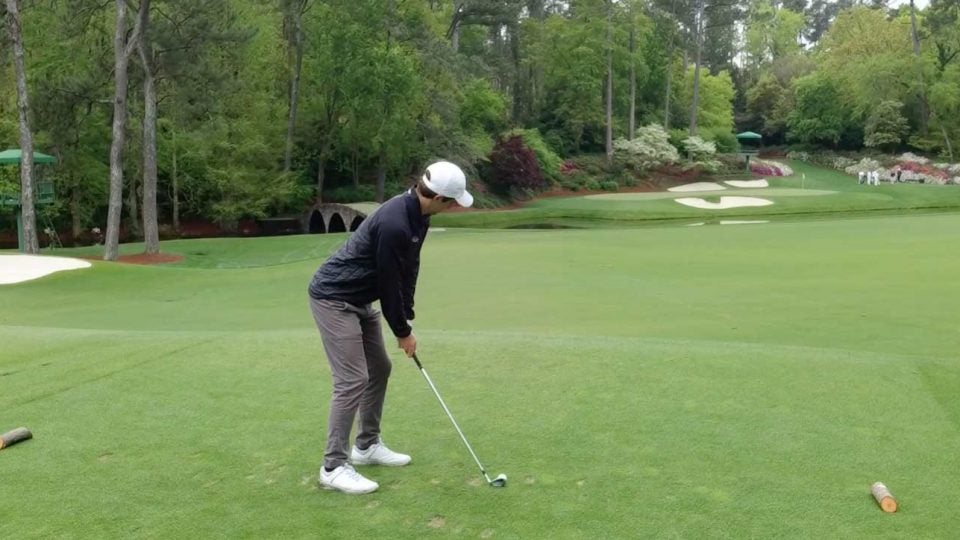Much to the chagrin of my more-seasoned peers across the Augusta National media center, my name was drawn from the magic green hat on Masters Friday, promising me entry into the world’s most famous grounds — to play! Hoo boy.
My colleague Alan Shipnuck has detailed the process media members go through to get this golden ticket, but here’s a quick summary: of the 800ish press that get credentialed for the Masters, 28 are selected to play the Monday after the Masters. Same pins, same conditions, but (this is smart and important) different tees. The course plays about 1,000 yards shorter.
I have extensively chronicled my unsuccessful bout with professional golf on this website, which meant that expectations from my colleagues — and my own inflated golf ego — were far higher than healthy.
Blessedly, the confidence of the public on Monday morning was far lower.
Our own @dylan_dethier is playing Augusta National today! What will he shoot?
— GOLF.com (@GOLF_com) April 9, 2018
Trying to manage my expectations, I set two goals: 1. Be as aggressive as possible, and 2. Make a birdie.
I’d ultimately fail at both. But here’s what I learned playing the National:
1. It’s an actual real-life golf course
Until being on property I’d never envisioned Augusta National as an actual property where you could, like, walk from one green to the next tee, or see what was going on from a different hole. I could only picture what I’d seen on TV, where they cut from one hole to the next several times per minute.
I wrote this in our staff Masters takeaways, but walking onto the course I was struck by the way the land stretched out before me. There was 1, and 9, and 10, and 18, and 8 and 2 and 3 beyond, hole after hole after hole, connected by tightly mown fairways and separated only by tall, tightly trimmed pines. Some areas are surprisingly close together: 9 green is just a pitch shot from 18 green, for example, and the drama on 15 and 16 happens right next to each other. But from the clubhouse, Amen Corner seems impossibly far away. The effect made the place feel both bigger and smaller than I expected.
2. Want a good score? Play the member tees
The Monday upgrade (we played from 6,350 yards) went a serious ways toward taking the teeth out of Augusta’s long game. The hardest holes in the tournament were 1, 4, 7, and 11. Take 80 yards off No. 1, 70 yards away from No. 4, 120 yards off No. 7, and 105 off No. 11? Different course. Sand wedge into a back pin on 11 is a heck of a lot different than, say, five-iron.
“Ah, if only they’d let me play the back tees,” I’d told my friends. On a rainy Monday morning with temperatures in the 40s coming off a week slumped over my laptop, I was glad to be playing Augusta Light.
3. Four tee shots are the most important
They’re the four par 5s. Hit it in the fairway? A definite go at the green awaits. Lay it up, on the other hand, and there are no guarantees, as none of these greens are a cinch to stick it with a wedge. I failed this test on the front nine with a snap-hook into the left hazard on No. 2 and a block into the right woods on No. 8.
When I got to No. 13, my caddie, Jay, gave me a properly conservative line before another caddie chimed in. “Jake Owen played here a couple weeks ago,” he said. “See that W in the trees? He hit it through there. Had 120 left.”
Jake Owen?! I’m better than Jake Owen, I thought. This turned out not to be true. One tree interrupted my ball’s flight and deposited it into Rae’s Creek. Not good. I overcompensated on 15, pushing another into the right woods. Oh-for-four put a real damper on my birdie goal.
4. Some of the landing areas are tiny
I had a 50-yard shot into the 3rd hole and it felt like there was nowhere to hit the ball. Land it short? It would catch the steep front slope and roll back halfway to my feet. Land it pin high? The sloping green, rock-hard even after the morning’s rain, would funnel it into the fairway beyond, leaving a tricky up and down. It was way harder than I thought it would be and perhaps my favorite unexpected hole.
5. Imprecision is roundly punished…
I feel like I have a better understanding of Augusta’s punishing slopes after staring a few of them down. I hit what I thought was a great shot into No. 9 green only to see it trundle off the front of the green. I caught the wrong slope coming into 14, too, and a shot that was nearly inside 10 feet ended up more like 35. Missing your spot by a little can leave you with a lot left to negotiate.
6. …but precision is rewarded big time
You know this from watching Sundays from the couch, but certain shots on Sunday at Augusta look SO easy when they’re executed the right way. A ball catching the slope and rolling back toward the hole on No. 2. Spinning off the backstop at No. 7. Catching the slope for a near-ace at 16. Given the advantage of the forward tees, I had wedges and short irons into nearly every green, but I didn’t crack the secret code of any of these shots. When I got up to the green I’d see something that made me reconsider the shot I’d just hit — and a strong desire to try again (I jokingly asked after the round if I could out for 18 more; they not jokingly told me my car was ready out front).
This dichotomy made sense to me: At Augusta, really good shots get even better, while anything sloppy gets punished. That’s part of the reason Augusta rewards good players so often — and players who have studied the course over several years. Unlocking the secrets at Augusta requires control of your shot shape, trajectory, and spin. If you can do that? Birdies await.
7. There are lots of scary shots. Here are the five scariest, ranked
5. Opening tee shot. Just make contact. I ended up right — though not quite Rory right — but thousands of fans and millions of dollars at stake may have pressured me into something far worse.
4. Approach on 3. There’s nowhere to land it!
3. Approach on 11. Even with a flip wedge, I’ve been trained through years of Masters online streaming to fear everything about this hole.
2. Wedge on 15. Downhill lie, water short, trouble long, plenty of recent visual evidence from our defending Masters champion as to how this could go wrong.
1. Tee shot on 12. I was determined to fire dead at this pin until halfway through my swing, when I could hear the taunts of colleague Sean Zak telling me I was going to go “full Spieth” and chunk a couple into the water. I settled for a pull hook that soared over the green — but stayed dry.
8. It’s actually pretty playable
A lot of the holes at Augusta are kind of… easy. Not, like, easy to make birdie on. But from the members’ tees, it’s easy to keep the ball in play. There are no bad lies — not in the fairway, or in the “second cut,” or on the pine straw, which is kept pleasantly free of pinecones (and squirrels, for that matter — an enduring mystery of Augusta. Where the squirrels at?)
Anyway, the point is that it’s easy to three-putt, or two-chip, but there are no gimmicks and therefore fewer opportunities for complete disaster (Sergio, if you’re reading this, I dunno, man. Sorry.)
9. It’s cliché to say but … the elevation! It’s amazing!
No. 10 would be an unbelievable sled run. This is every first-timer’s observation but still bears mentioning.
10. Playing the Sunday pins is so much fun
Augusta is a great course on its own merits, but what makes it special is that we know it well. The shots I hit felt familiar, even though I’d never been there. Can a round of golf be nostalgic at a course you’ve never been to? Putting to Sunday pins on lines I’ve seen a thousand times (lines that I still would have screwed up without the helpful hand of my veteran caddie) was extra cool.
11. The trees are dead solid
Stuck in the right woods on 8 but determined to go for the green, I took an aggressive rip from the pine straw, hoping to sneak it by a tree that had been leering at me from 30 yards in front of me. What were the odds that I’d hit it, anyway? Pretty good, as it turned out: My ball hit dead-center trunk and reversed course, sailing back over my head and through the woods. I had 190 yards in for my second shot and 240 in for my third.
12. I showed up the Twitter doubters!
My scorecard was incredibly plain: bookend bogeys on No. 1 and No. 18 plus another at No. 13. Fifteen pars, three bogeys, and zero birdies (sad!) added up to a 75. It was a pretty honest score, although a couple times I arrived to my ball to find it suspiciously trouble free (as in the left woods on No. 2) perhaps the work of a particularly skilled caddie. In all, I felt like I played pretty well; certainly your average course from 6,350 would play much easier than this one. I had several birdie putts that scared the hole, the worst miss being from six feet on 15. But I loved being able to get creative around the greens and chipped and putted well, getting up and down five times and avoiding any three-putts. It’s easy to imagine taking advantage of the par 5s and chopping a few strokes off that score, but if I’d gotten uncomfortable around the hockey-rink greens I could’ve just as easily failed to break 80.
13. The takeaway? It’s complicated
Going into the week, I had two different competing feelings about Augusta National:
1. Augusta National, home of the biggest tournament in golf. Iconic, recognizable, dramatic, fun, and the site of some of the greatest stretches and shots in the game’s history, and the canvas for drama year after year. The most reliably entertaining stage in golf.
2. A symbol of old money excess and a bastion of the sort of exclusivity and racism/sexism that have plagued the game from the outset. It’s a literal old boys’ club, with a membership still largely comprised of wealthy old white men.
Spending the week on property was certainly a reminder of the excess, but also this: Once you get away from the too-perfect clubhouse and out onto the course, you’re reminded that this is in some ways the peak of golf. Hole variety. Risk-reward. Incredible beauty. Serenity. Drama. Trees and water, tight corners and open expanses, flowers and birdsong. It’s alluring, and amazing, and surreal. But at the end of the day, the pull of the game is the same at Augusta as it was for a nine-dollar round I’d played in South Carolina the week before.
There’s a good chance I’ll never play either course again.









